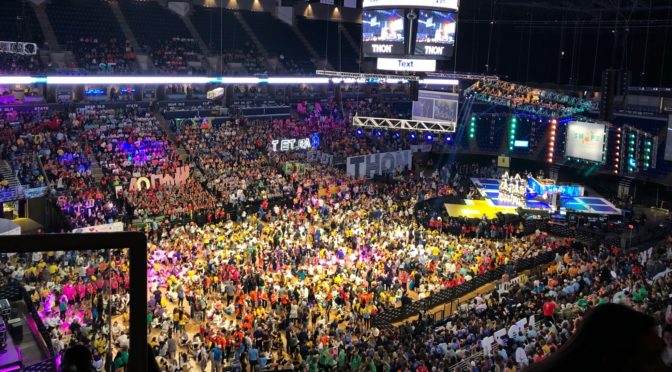In the predawn darkness outside the Bryce Jordan Center at Penn State, it sounded like an all-night rave was in full swing, complete with thrashing guitar music.
Inside, a kaleidoscope of colors – thousands of students wearing bright T-shirts of blue, green, red, pink, white, yellow and purple — filled the arena.
From the upper seats, it looked like a living pointillist painting.
In the corridors, grown-ups, many of them parents of students, such as myself, wore the thousand-yard stares that come with being up too early with too little coffee.
But in the arena at 4:45 a.m., the energy level was soaring. The students were nearing the 12th hour of what would be a no-sitting, no-sleeping 46-hour dance-athon known as THON.
The event, described by organizers as the largest student-run philanthropy in the world, raises money to benefit kids with cancer and their families.
For those of a certain age, it’s reminiscent of the Jerry Lewis Labor Day telethons that raised money for the Muscular Dystrophy Association.
Unlike those of telethons of old, which relied on a stream of appearances by an assortment of Grade B celebrities and entertainers, THON is fueled by more than 16,000 student volunteers.
The numbers THON racks up are truly staggering:
• 16 committees oversee everything, from public relations to operations and security. The volunteers are designated by their different colored T-shirts.
• 2,000 student fundraisers over the year benefit THON
• 650,000 THONvelopes sorted and distributed to raise money
• $10.6 million raised in 2019, with the money benefitting pediatric cancer patients and their families at the Penn State Milton S. Hershey Medical Center. Those families never get a bill for what insurance does not cover.
• Since THON’s start more than 40 years ago, it’s raised $157 million.
The arena during THON has the feel of a bustling airport, political convention and Olympics opening ceremony all rolled into one.
Look beyond the sheer logistics and details of organizing, however, and you will find at its core an indomitable spirit of giving, empathy and commitment.
The uniting principle of THON is “For the Kids,” and it is on display everywhere: Posters created by students and families, head bands that say “No Hair, Just Don’t Care,” worn by students who have shaved their heads in solidarity with pediatric cancer patients, photos and, of course, the T-shirts.
Families and cancer survivors came on stage and offered powerful, moving testimonials.
Parents whose sons and daughters did not survive also paid tribute to their loved ones, followed by a slide show of those who died.
It occurred to me about halfway through the slide show that it was fitting that college students – filled with the energy and exuberance of youth – tackle such a monumental undertaking as helping kids with cancer.
Adults, especially parents, would be too crippled by the enormity of the undertaking. I know I would be, and my boys, thank God, are healthy.
I was struck by one mother of a cancer survivor who said: “Don’t stop when you’re tired. Stop when you’re done.”
In its slogan, THON embraces that fully: “One day we will dance in celebration. Until then, we dance for a cure.”
For the kids.


